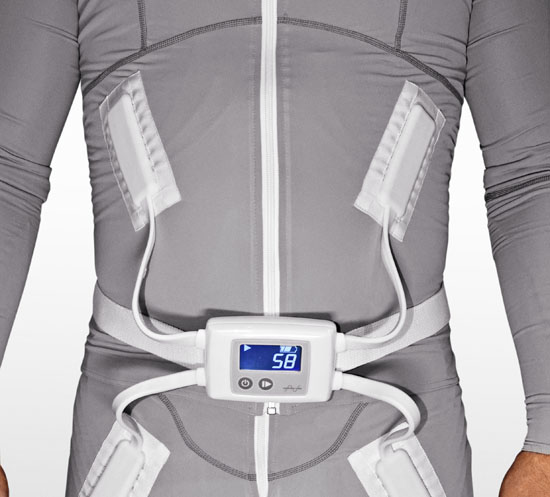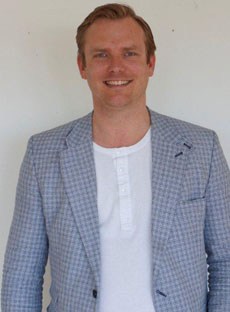Suited for treatment of brain damage
Garment developed at KTH can increase mobility and reduce pain
Health
For those with brain damage or neurological disorders, treatment could be as close as the wardrobe.

An alternative to painful treatments and surgery for brain damage may now be available with a specially-designed elastic body suit fitted with electrodes, which was designed at KTH Royal Institute of Technology in collaboration with health care and business partners.
The Mollii garment could improve range of motion and reduce pain for people with brain injuries and neurological disorders such as MS and cerebral palsy.
The garment provides the body with electrical stimulation to ease tension and spasms. The result is reduced pain perception and increased mobility.
The idea originated with a Swedish chiropractor, Fredrik Lundqvist, who worked with rehabilitation of brain-damaged patients. Lundqvist struck upon the idea of sewing electrical stimuli – similar to TENS (transcutaneous electrical nerve stimulation) electrodes – into garments that the patient can wear.

He turned to KTH researchers Johan Gawell and Jonas Wistrand at the Department of Machine Design. “They produced a prototype of the product, and today they are working full time on the development of Mollii,” Lundqvist says.
“We need more engineers in care,” Lundqvist says. “I believe that dedicated, young people who are passionate about the future should be given a free hand to develop innovations.”
Designed with ordinary swimsuit material, the body suit has conductive elastic sewn into it, with electrodes located at the major muscles.
Battery-powered light current is conducted via silver wires to 58 electrodes attached to the inside of the garment, which in turn stimulate as many as distinct 42 muscles, according to the patient’s needs.
Batteries are placed in a small control box fitted at the waistband.
“The idea is that the clothes should be used for a few hours, three times a week, and the effect is expected to last for up to two days,” Lundqvist says.
Users are advised engage in movement through training and stretching during the treatment.
“To enhance the quality of life the patient may choose to use Mollii before it's time to go to work, school or to a social event. That enables the body to function as well as possible when it is really needed,” he says.
The garment has been shown to be highly effective in patient examinations performed in collaboration with a PhD student Stockholm’s Karolinska Institute, Lundvist says. “One-hundred percent of the participants in the survey say they have experienced improvements in existing function or quality of life,” he says.
Stroke patients with paralysis on one side have been found to gain increased mobility in spastic limbs, in that they had improved gait and their arms and hands worked better after treatment.
“As a bonus, the patients often sleep better, and their pharyngeal motor skills and speech improved after using Mollii,” Lundqvist says.
The treatment of patients with movement difficulties and pain due to neurological damage can often require surgery, injections of botolinumtoxin (neurotoxin) or strong medications.
“These treatments mean high costs and side effects, while our clothes are simple and safe to use,” Lundqvist says. “You can reduce the number of hospital visits because the therapy can be performed at home. And when the mobility increases, there is less need for walkers or wheelchairs.”
Mollii is an approved CE marked medical device, but independent clinical tests have yet been performed. But the company behind the treatment, Inerventions, has launched a scientific study of the clinical effectiveness of the garment, in partnership with Rehab Medical clinics in Linköping and Borås. Lundqvist says the results should come next year.

Today, Mollii is available through the Swedish health care system as a personal tool prescribed by physical or occupational therapists. And the garment can also be purchased directly from Inerventions.
The price is about EUR 5,600 for two years guaranteed spasticity treatment. If the suit during that time becomes too small, the patient can switch to a new, tested garment at no additional cost.
In Denmark, the garment is already subsidized with municipal funds for treatment of nerve damage, based on recommendations from a physiotherapist.
Inerventions’ goal is to establish Mollii in Europe, the U.S. and Japan. The garment can in the future be used to help patients with chronic pain and people with Restless Legs Syndrome (RLS).
“It can also help children with physical disabilities or motor difficulties in the feet, such as constantly walking on toes or with their feet at inward angles,” Lundqvist says.
For more information contact Fredrik Lundqvist at +46 (0) 70 270 70 24 or fredrik@inerventions.se .
Katarina Ahlfort
Patient groups that Mollii treatment targets
- Acquired brain injuries, including stroke, traumatic brain injury, brain damage from tumors and hypoxia from drowning.
- Congenital brain damage, including MS and Parkinson's.
- Brain lesions in an immature nervous system, including cerebral palsy .
Mollii project history and future
- The CEO of Inerventions, Fredrik Lundqvist, got start-up grants for the project through a presentation on the television program, Draknästet, on Swedish state TV in 2010.
- The Mollii garment was awarded the Robotdalen Innovation Award earlier in 2013 when it was marketed under its former name, the Elektrodress. Mollii has both process and product patents.
- KTH researchers created Mollii in collaboration with research groups at the University of Borås and businesses FOV Fabrics and Inerventions.
- The Mollii project has been financially supported by Vinnova, Knowledge Foundation, Promibilia Foundation, Jimmy Dahlsten Foundation and the Norrbacka-Eugenia Foundation.
- Researchers at the Center for Technology in Medicine and Health (CTMH), a joint project between KTH , Karolinska Institute and the Stockholm County Council, participate in the development of Mollii through research, coordination of research efforts and advice.